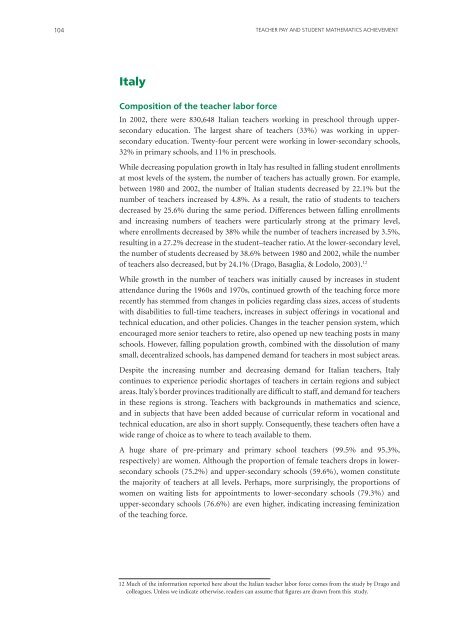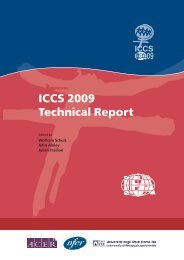Teacher Education and Development Study in Mathematics - IEA
Teacher Education and Development Study in Mathematics - IEA
Teacher Education and Development Study in Mathematics - IEA
You also want an ePaper? Increase the reach of your titles
YUMPU automatically turns print PDFs into web optimized ePapers that Google loves.
104<br />
TEACHER PAY AND STUDENT MATHEMATICS ACHIEVEMENT<br />
Italy<br />
Composition of the teacher labor force<br />
In 2002, there were 830,648 Italian teachers work<strong>in</strong>g <strong>in</strong> preschool through uppersecondary<br />
education. The largest share of teachers (33%) was work<strong>in</strong>g <strong>in</strong> uppersecondary<br />
education. Twenty-four percent were work<strong>in</strong>g <strong>in</strong> lower-secondary schools,<br />
32% <strong>in</strong> primary schools, <strong>and</strong> 11% <strong>in</strong> preschools.<br />
While decreas<strong>in</strong>g population growth <strong>in</strong> Italy has resulted <strong>in</strong> fall<strong>in</strong>g student enrollments<br />
at most levels of the system, the number of teachers has actually grown. For example,<br />
between 1980 <strong>and</strong> 2002, the number of Italian students decreased by 22.1% but the<br />
number of teachers <strong>in</strong>creased by 4.8%. As a result, the ratio of students to teachers<br />
decreased by 25.6% dur<strong>in</strong>g the same period. Differences between fall<strong>in</strong>g enrollments<br />
<strong>and</strong> <strong>in</strong>creas<strong>in</strong>g numbers of teachers were particularly strong at the primary level,<br />
where enrollments decreased by 38% while the number of teachers <strong>in</strong>creased by 3.5%,<br />
result<strong>in</strong>g <strong>in</strong> a 27.2% decrease <strong>in</strong> the student–teacher ratio. At the lower-secondary level,<br />
the number of students decreased by 38.6% between 1980 <strong>and</strong> 2002, while the number<br />
of teachers also decreased, but by 24.1% (Drago, Basaglia, & Lodolo, 2003). 12<br />
While growth <strong>in</strong> the number of teachers was <strong>in</strong>itially caused by <strong>in</strong>creases <strong>in</strong> student<br />
attendance dur<strong>in</strong>g the 1960s <strong>and</strong> 1970s, cont<strong>in</strong>ued growth of the teach<strong>in</strong>g force more<br />
recently has stemmed from changes <strong>in</strong> policies regard<strong>in</strong>g class sizes, access of students<br />
with disabilities to full-time teachers, <strong>in</strong>creases <strong>in</strong> subject offer<strong>in</strong>gs <strong>in</strong> vocational <strong>and</strong><br />
technical education, <strong>and</strong> other policies. Changes <strong>in</strong> the teacher pension system, which<br />
encouraged more senior teachers to retire, also opened up new teach<strong>in</strong>g posts <strong>in</strong> many<br />
schools. However, fall<strong>in</strong>g population growth, comb<strong>in</strong>ed with the dissolution of many<br />
small, decentralized schools, has dampened dem<strong>and</strong> for teachers <strong>in</strong> most subject areas.<br />
Despite the <strong>in</strong>creas<strong>in</strong>g number <strong>and</strong> decreas<strong>in</strong>g dem<strong>and</strong> for Italian teachers, Italy<br />
cont<strong>in</strong>ues to experience periodic shortages of teachers <strong>in</strong> certa<strong>in</strong> regions <strong>and</strong> subject<br />
areas. Italy’s border prov<strong>in</strong>ces traditionally are difficult to staff, <strong>and</strong> dem<strong>and</strong> for teachers<br />
<strong>in</strong> these regions is strong. <strong>Teacher</strong>s with backgrounds <strong>in</strong> mathematics <strong>and</strong> science,<br />
<strong>and</strong> <strong>in</strong> subjects that have been added because of curricular reform <strong>in</strong> vocational <strong>and</strong><br />
technical education, are also <strong>in</strong> short supply. Consequently, these teachers often have a<br />
wide range of choice as to where to teach available to them.<br />
A huge share of pre-primary <strong>and</strong> primary school teachers (99.5% <strong>and</strong> 95.3%,<br />
respectively) are women. Although the proportion of female teachers drops <strong>in</strong> lowersecondary<br />
schools (75.2%) <strong>and</strong> upper-secondary schools (59.6%), women constitute<br />
the majority of teachers at all levels. Perhaps, more surpris<strong>in</strong>gly, the proportions of<br />
women on wait<strong>in</strong>g lists for appo<strong>in</strong>tments to lower-secondary schools (79.3%) <strong>and</strong><br />
upper-secondary schools (76.6%) are even higher, <strong>in</strong>dicat<strong>in</strong>g <strong>in</strong>creas<strong>in</strong>g fem<strong>in</strong>ization<br />
of the teach<strong>in</strong>g force.<br />
12 Much of the <strong>in</strong>formation reported here about the Italian teacher labor force comes from the study by Drago <strong>and</strong><br />
colleagues. Unless we <strong>in</strong>dicate otherwise, readers can assume that figures are drawn from this study.

















